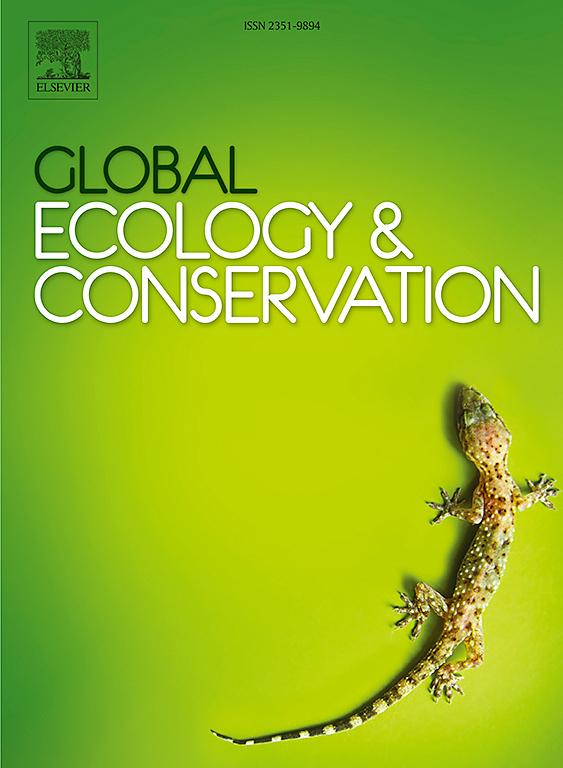Forty years of dynamics: Population trends and habitat changes of the Black-necked Crane (Grus nigricollis) in China
IF 3.5
2区 环境科学与生态学
Q1 BIODIVERSITY CONSERVATION
引用次数: 0
Abstract
Over 95 % of Black-necked Cranes (Grus nigricollis) are found on the Qinghai-Tibet Plateau and the Yunnan-Guizhou Plateau. Due to effective conservation efforts, the population of the Black-necked Crane has experienced significant growth. However, a comprehensive review of their breeding and wintering habitats remains lacking, and the relationship between population dynamics and habitat changes is not yet fully understood. This study, therefore, analyzes population trends and habitat alterations across 13 key nature reserves in China. It explores the underlying factors contributing to the species' remarkable population recovery, summarizes current conservation strategies, identifies major threats, and provides recommendations for future conservation efforts. The results revealed the following: (1) The population of Black-necked Cranes increased from approximately 5600–6000 individuals in the early 1990s to 17,389–17,610 individuals in 2022, with 92 % of the reserves exhibiting positive population growth. (2) Breeding habitats were primarily composed of grasslands, wetlands, and water bodies, with a notable shift from wetland degradation to recovery. The combination of habitat type and habitat change significantly affected the population in breeding areas, with grasslands being the most significant habitat type influencing population changes (p = 0.03). Wintering habitats were mainly croplands, grasslands, and water bodies, with a significant decline in cropland availability. While habitat type and habitat change did not significantly affect population changes in wintering areas (p = 0.70), the increase in population is largely attributed to effective human conservation measures. (3) Despite conservation successes, the Black-necked Crane remains threatened by climate change and human activities. Economic development and reserve management must fully consider these impacts to ensure the species' long-term survival. This study provides a scientific basis for the conservation of Black-necked Cranes and recommends the establishment of a coordinated protection mechanism to address future challenges.
中国黑颈鹤(Grus nigricollis)种群动态与生境变化
95% 以上的黑颈鹤(Grus nigricollis)分布在青藏高原和云贵高原。由于有效的保护措施,黑颈鹤的数量有了显著的增长。然而,对其繁殖和越冬生境的全面研究仍然缺乏,种群动态与生境变化之间的关系尚未完全了解。因此,本研究分析了中国13个重点自然保护区的种群趋势和栖息地变化。它探讨了导致该物种显著数量恢复的潜在因素,总结了当前的保护策略,确定了主要威胁,并为未来的保护工作提供了建议。结果表明:(1)黑颈鹤种群数量从20世纪90年代初的5600 ~ 6000只增加到2022年的17389 ~ 17610只,有92% %的保护区种群数量出现正增长。(2)养殖生境以草地、湿地和水体为主,湿地退化向恢复转变明显。生境类型和生境变化的组合对繁殖区种群数量有显著影响,其中草地是影响种群变化最显著的生境类型(p = 0.03)。越冬生境以农田、草地和水体为主,耕地可利用性显著下降。生境类型和生境变化对越冬区种群数量的影响不显著(p = 0.70),种群数量的增加主要归因于有效的人类保护措施。(3)尽管保护工作取得了成功,但黑颈鹤仍然受到气候变化和人类活动的威胁。经济发展和保护区管理必须充分考虑这些影响,以确保该物种的长期生存。本研究为黑颈鹤的保护提供了科学依据,并提出了建立协调保护机制以应对未来挑战的建议。
本文章由计算机程序翻译,如有差异,请以英文原文为准。
求助全文
约1分钟内获得全文
求助全文
来源期刊

Global Ecology and Conservation
Agricultural and Biological Sciences-Ecology, Evolution, Behavior and Systematics
CiteScore
8.10
自引率
5.00%
发文量
346
审稿时长
83 days
期刊介绍:
Global Ecology and Conservation is a peer-reviewed, open-access journal covering all sub-disciplines of ecological and conservation science: from theory to practice, from molecules to ecosystems, from regional to global. The fields covered include: organismal, population, community, and ecosystem ecology; physiological, evolutionary, and behavioral ecology; and conservation science.
 求助内容:
求助内容: 应助结果提醒方式:
应助结果提醒方式:


